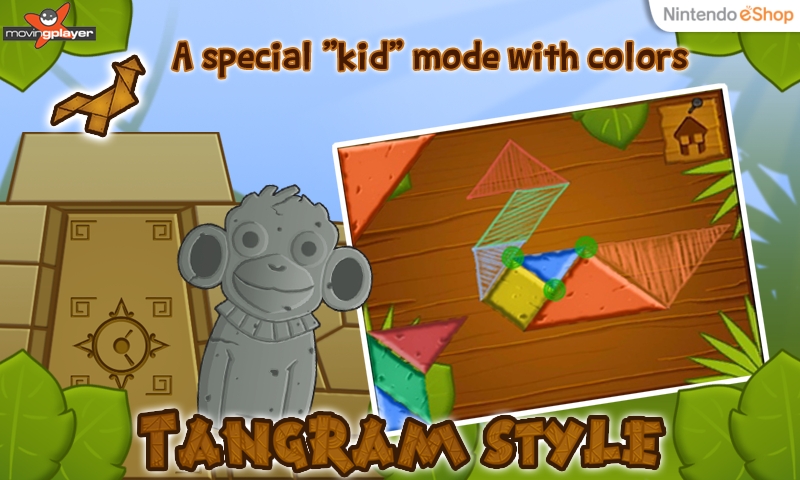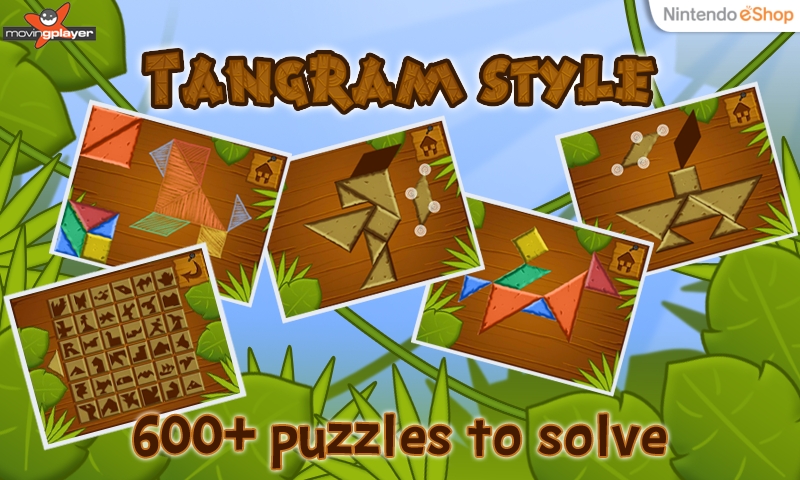PN Review: Tangram Style
Tangram Style is a puzzle game that was recently released on the 3DS. There is not much to Tangram puzzle games and I have to give credit to Moving Player, the developer, for trying to make the game interesting by adding a Mayan styling to the game. Unfortunately, the unique styling doesn’t make the game any more interesting than the next Tangram puzzler.
Tangram Style a very straight forward puzzle game where players use Tangrams, which most of us are familiar with from our time as a young child, to replicate shapes shown on screen. Tangram Style includes 4 different modes. Child Mode is the easiest mode of them all providing players with colored pieces and corresponding shadows to help younger audiences complete the final shapes. Classic Mode is like Child Mode except the pieces and shadows are not colored. In Classic Mode, players are given tan pieces to arrange in monochrome shadows. For players that want a challenge should give Challenge Mode and One Touch Mode a try. Challenge Mode is a time attack style where players will be asked to complete a specific number of puzzles within the time limit. One Touch Mode allows players to manipulate one piece at a time and once a new piece is selected, the previous piece is locked into place. So while playing One Touch, players will want to be sure that pieces are in the right spot before moving on to other puzzle pieces.
There are a ton of puzzles in Tangram Style but there were some difficult puzzles early on in the game, which could frustrate some players. Fortunately, puzzles don’t necessarily need to be completed in order so difficult puzzles can be skipped but more puzzles are unlocked depending on how many have been completed. With so many puzzles available, Tangram Style offers a good amount of playtime but after a while the puzzles become very repetitive and uninspired. Each puzzle provides players with the same set of pieces with the same goal of trying to arrange said pieces into the shadow. The only difference from puzzle to puzzle is the shape of the shadow that is provided.
Tangram Style menu music is nice but it is limited to the initial game menus. As soon as players jump into a puzzle the pleasant game music is replaced by ambient jungle sound effects. These sound effects would not be too bad if they were not as repetitive as the gameplay. What makes the sound effects in Tangram Style even more annoying is the clicking sound that is made every time the stylus makes contact with the touchscreen. A combination of both the jungle ‘music’ and the tapping sound effect will likely compel most players, including myself, to play Tangram Style sans sound.
Being a 3DS game, I expected Tangram Style to do something with the top 3D screen. Make no mistake, Tangram Style does show 3D visuals on the top screen but there is nothing of substance that adds to the gameplay experience. In fact, most of my time with Tangram Style is spent looking almost exclusively at the touch screen, which is used to control everything in the game. The touchscreen-only play style used in Tangram Style, which is most conducive for this type of game, works rather well most of the time. Occasionally Tangram Style will become very finicky and players will find themselves making fine adjustments to the pieces within the shadow to get the game to ‘accept’ the finished puzzle.
Overall Tangram Style is a solid puzzle game experience but the game suffers from the lack of variety in all other aspects of the game outside of the shadows provided in the puzzles. Tangram Style could have been a much different experience with an expanded musical track that played during puzzles, different styled levels that changed as players progressed through the puzzles, and a larger variety in the puzzle pieces. The different game modes do provide some variety but not enough to make Tangram Style a spectacular game. For players looking for a good puzzle game and a way to fill time that would otherwise go to waste, Tangram Style fits the bill.





